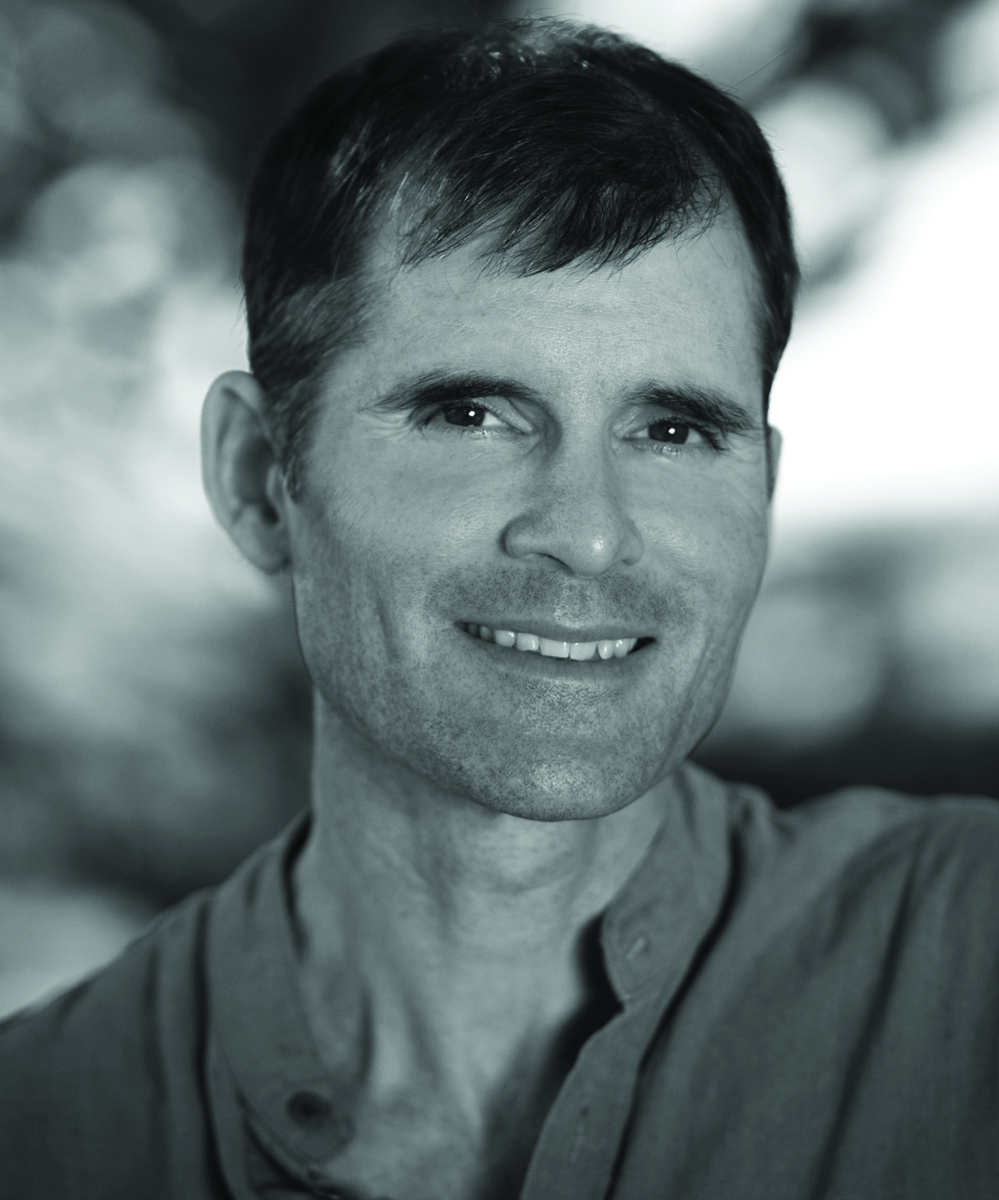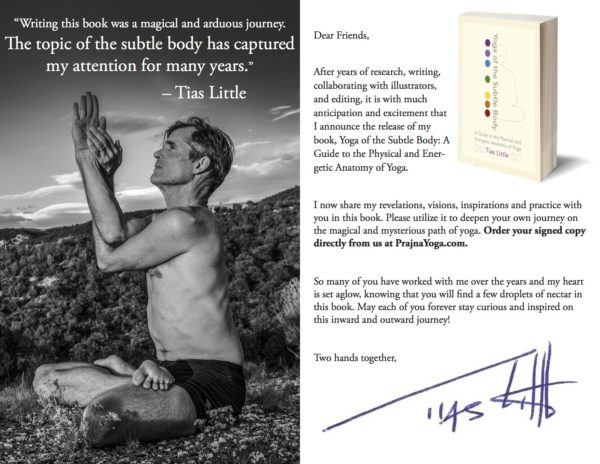
19 Jul Telluride Yoga Fest: Tias Little
Tickets/passes to the Telluride Yoga Festival here. Please scroll down to the bottom of the story to listen to returning instructor Tias Little’s podcast. Book-signing for Tias’ “Yoga of the Subtle Body,” at Between the Coves Bookstore, Sunday, July 24, 1:30 – 3:30 p.m.

Tias Little
Chakras, nadis, and koshas
Are the words Greek – rather Sanskrit – to you?
Very simple definitions are as follows:
Chakras are energy centers that run along the spinal column. They are believed to be part of the subtle body, not the physical body, and as such, are the meeting points of the subtle (non-physical) energy channels called nadis.
The nadis are believed to be channels in the subtle body through which the life force or prana or vital energy moves.
Koshas or “layers” or “sheaths” of our body were charted by yogic sages some 3,000 years ago. Written about in the Upanishads, the kosha model navigates an inner journey— starting from the periphery or physical body, the annamaya kosha, and moving towards the core of the Self, the embodied soul or bliss body, the anandamaya kosha.
While all of the above may sound mystical and esoteric, chakras, nadis, and koshas all serve as practical and profound contemplative tools that can help deepen a yoga practice – and the quality of your participation in life.
The Big Idea, that yoga is a journey inward with personal transformation the goal, is explained in Tias Little’s latest book, “Yoga of the Subtle Body: A Guide to the Physical and Energetic Anatomy of Yoga.”

“The body and spirit are exact mirrors of each other – a fact much more apparent to the ancients than to those of us distracted by our modern materialism. Tias even-handedly blends the anatomy we know today with the anatomy of the energetic body. His many years of experience imbue this book with an easy authority,” Thomas Meyers, author, “Anatomy Trains.”
The upcoming Telluride Yoga Fest kicks off Thursday, July 21, 9 a.m. – 3 p.m. with two workshops, both designed to help participants go way deeper than the physical poses or asanas that for most Westerners rhyme with the word “yoga”: Dr. Alanna Kaivalya teaches “Yoga Beyond the Mat: Making Yoga Your Spiritual Practice”; Tias expands upon core ideas from the new book, teaching the “Wisdom of the Subtle Body.”
From the description for the intensive:
“…Underlying our teaching is that we do not do poses for the sake of the pose, but for the quality of attention within the pose. Through guided meditation, somatic awareness, and yoga postures, this is a transformational day of practice and study…”
Tias Little is everywhere you want to be at the Telluride Yoga Festival.
In addition to the workshop, the three other classes Tias is teaching over the weekend are all based on the principles of Prajna Yoga, his holistic approach to practicing and studying that incorporates anatomy, yoga and Buddhist meditation, Iyengar and Ashtanga principles of structure, alignment, and movement, diet and the language of yoga or Sanskrit.
Whatever he is teaching, Tias tends to guide his students elegantly and efficiently according to the principle of vinyasa krama, taking the right steps in the right order at the right time to cultivate the mind-body connection through asana, pranayama, meditation, sensory sensitivity, concentration practices, and the study of sacred texts. The payoff is always the same: enhanced self-awareness, health, and serenity.
Friday, 11 a.m. Tias leads “Opening the Pathway of the Nadis,” a workshop designed to help students sense and feel the movement of the life force (prana) through these energy channels. (All levels.)

Tias in crow pose.
Saturday, July 23, 8 p.m., is all about “Developing the Diamond Mind” or a mind that clings to nothing and is able to cut through obssessiveness and delusion. (All levels.)
Sunday, 11 a.m. explores “The Flight of the Crane.” The crane pose (often called “crow”) has powerful effects on the internal organs and spine. It brings lightness and pliability to the body and allows for a feeling of flying. The class also investigates the metaphor of the crane as it appears in the meditative traditions of Zen, yoga, and Taoist practices. (Pre-requisite: Students must be stable and healthy in the low back and shoulders.)
On Friday, 5:30 p.m., Tias joins a panel of other top presenters to share “Yoga Stories.”
To learn more about Tias Little, listen to his podcast.
More about Tias Little:

Tias and Surya Little, both returning instructors at the 2016 Telluride Yoga Festival.
Like a number of his colleagues in town for the annual Telluride Yoga Festival, Tias Little could be described as a rock star in the yoga world. He certainly has legions of devoted students and followers – however, message tank tops and loud music, increasingly popular in yoga studios across the country, are not his stock in trade.
The Sanskrit word “prajna” (from”pra” or before and the root “jna,” to know) can be variously translated as “wisdom,” “insight” ” profound understanding,” “discernment,” and “know-how.” In the Buddhist tradition, prajna connotes true or transcendental wisdom, one of the highest attainments of practice. In contrast to mere brain-mind ratiocination, prajna is a knowing that permeates the cells of our bodies. Tias’s teaching brings together precision of alignment, anatomical detail, and a profound meditative experience.
Tias was hardwired to know all that he knows profoundly. His mother Susan Little taught Iyengar and, in 1984, she began instructing Tias in this therapeutic lineage.
In 1989,Tias took his first trip to India, living in Mysore for six months to learn the first two series of Ashtanga Vinyasa Yoga at the feet of the master, K. Pattabhi Jois.
After practicing Ashtanga Yoga for 10 years, Tias went on to immerse himself in the study of the healing arts, including massage, cranial-sacral therapy, and bodywork. His practice and teaching is influenced by the work of Ida Rolf, Moshe Feldenkrais, and Thomas Hanna.
In 1998, Tias earned an MA in Eastern Philosophy from St. John’s College. His dharma training was further informed by teachings from the Zen and Vipassana communities.
Tias is the author of three books, “The Thread of Breath,” “Meditations on a Dewdrop,” and “Yoga of the Subtle Body.”


Sorry, the comment form is closed at this time.